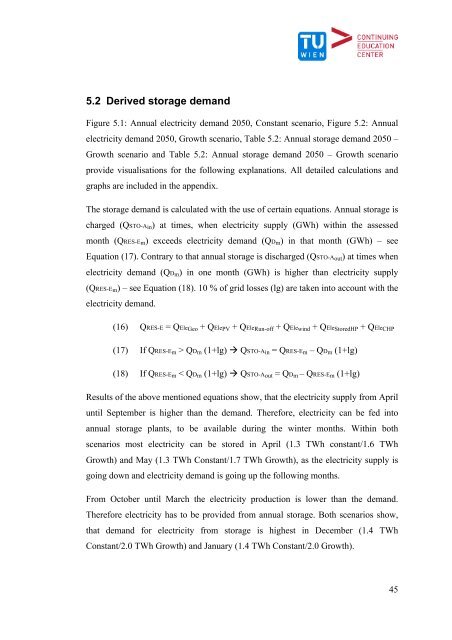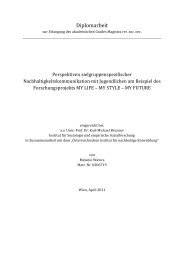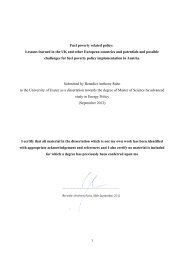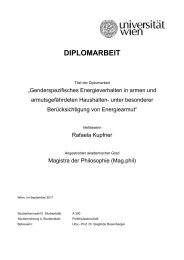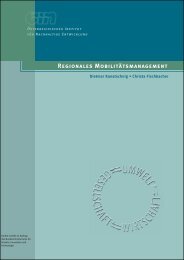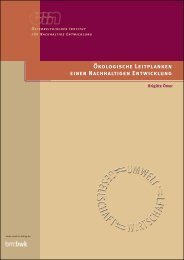The relevance of energy storages for an autarky of electricity supply ...
The relevance of energy storages for an autarky of electricity supply ...
The relevance of energy storages for an autarky of electricity supply ...
Create successful ePaper yourself
Turn your PDF publications into a flip-book with our unique Google optimized e-Paper software.
5.2 Derived storage dem<strong>an</strong>d<br />
Figure 5.1: Annual <strong>electricity</strong> dem<strong>an</strong>d 2050, Const<strong>an</strong>t scenario, Figure 5.2: Annual<br />
<strong>electricity</strong> dem<strong>an</strong>d 2050, Growth scenario, Table 5.2: Annual storage dem<strong>an</strong>d 2050 –<br />
Growth scenario <strong>an</strong>d Table 5.2: Annual storage dem<strong>an</strong>d 2050 – Growth scenario<br />
provide visualisations <strong>for</strong> the following expl<strong>an</strong>ations. All detailed calculations <strong>an</strong>d<br />
graphs are included in the appendix.<br />
<strong>The</strong> storage dem<strong>an</strong>d is calculated with the use <strong>of</strong> certain equations. Annual storage is<br />
charged (QSTO-Ain) at times, when <strong>electricity</strong> <strong>supply</strong> (GWh) within the assessed<br />
month (QRES-Em) exceeds <strong>electricity</strong> dem<strong>an</strong>d (QDm) in that month (GWh) – see<br />
Equation (17). Contrary to that <strong>an</strong>nual storage is discharged (QSTO-Aout) at times when<br />
<strong>electricity</strong> dem<strong>an</strong>d (QDm) in one month (GWh) is higher th<strong>an</strong> <strong>electricity</strong> <strong>supply</strong><br />
(QRES-Em) – see Equation (18). 10 % <strong>of</strong> grid losses (lg) are taken into account with the<br />
<strong>electricity</strong> dem<strong>an</strong>d.<br />
(16) QRES-E = QEleGeo + QElePV + QEleRun-<strong>of</strong>f + QElewind + QEleStoredHP + QEleCHP<br />
(17) If QRES-Em > QDm (1+lg) à QSTO-Ain = QRES-Em – QDm (1+lg)<br />
(18) If QRES-Em < QDm (1+lg) à QSTO-Aout = QDm – QRES-Em (1+lg)<br />
Results <strong>of</strong> the above mentioned equations show, that the <strong>electricity</strong> <strong>supply</strong> from April<br />
until September is higher th<strong>an</strong> the dem<strong>an</strong>d. <strong>The</strong>re<strong>for</strong>e, <strong>electricity</strong> c<strong>an</strong> be fed into<br />
<strong>an</strong>nual storage pl<strong>an</strong>ts, to be available during the winter months. Within both<br />
scenarios most <strong>electricity</strong> c<strong>an</strong> be stored in April (1.3 TWh const<strong>an</strong>t/1.6 TWh<br />
Growth) <strong>an</strong>d May (1.3 TWh Const<strong>an</strong>t/1.7 TWh Growth), as the <strong>electricity</strong> <strong>supply</strong> is<br />
going down <strong>an</strong>d <strong>electricity</strong> dem<strong>an</strong>d is going up the following months.<br />
From October until March the <strong>electricity</strong> production is lower th<strong>an</strong> the dem<strong>an</strong>d.<br />
<strong>The</strong>re<strong>for</strong>e <strong>electricity</strong> has to be provided from <strong>an</strong>nual storage. Both scenarios show,<br />
that dem<strong>an</strong>d <strong>for</strong> <strong>electricity</strong> from storage is highest in December (1.4 TWh<br />
Const<strong>an</strong>t/2.0 TWh Growth) <strong>an</strong>d J<strong>an</strong>uary (1.4 TWh Const<strong>an</strong>t/2.0 Growth).<br />
45


